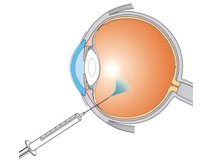
Intravitreal injections are a common medical procedure in ophthalmology in which medications are injected into the vitreous cavity of the eye. The vitreous is the gel-like substance that fills the space between the lens and the retina. Intravitreal injections are used for various eye conditions, including macular degeneration, diabetic retinopathy, and retinal vein occlusion. Here are key points about intravitreal injections:
Indications:
- Age-Related Macular Degeneration (AMD): Intravitreal injections are commonly used to deliver anti-vascular endothelial growth factor (anti-VEGF) drugs to treat neovascular (wet) AMD.
- Diabetic Retinopathy: Anti-VEGF injections are also used to treat diabetic macular edema and proliferative diabetic retinopathy.
- Retinal Vein Occlusion: Intravitreal injections can be used to treat macular edema associated with retinal vein occlusion.
- Other Retinal Conditions: They may be used in the management of other retinal disorders, including macular edema, uveitis, and certain types of infections.
Anti-VEGF Medications:
- Commonly used anti-VEGF drugs include ranibizumab (Lucentis), bevacizumab (Avastin), and aflibercept (Eylea).
- These medications work by inhibiting the action of vascular endothelial growth factor, which is involved in the growth of abnormal blood vessels and the leakage of fluid in the retina.
Procedure:
- Intravitreal injections are typically performed in an outpatient setting.
- Before the injection, the eye is numbed with local anesthesia, and the eyelids and surrounding area may be cleaned with an antiseptic solution.
- The injection is usually given through the sclera (white part of the eye) near the edge of the cornea.
Frequency of Injections:
- The frequency of intravitreal injections varies depending on the underlying eye condition and the response to treatment.
- Some patients may require injections monthly, while others may have a less frequent schedule.
Monitoring and Follow-up:
- Patients receiving intravitreal injections require regular follow-up appointments to monitor the response to treatment, assess visual acuity, and evaluate the overall health of the eye.
- Adjustments to the treatment plan may be made based on the clinical findings.
Potential Complications:
- While intravitreal injections are generally safe, there are potential risks and complications, including infection, bleeding, and increased intraocular pressure.
- Sterile techniques and proper monitoring are essential to minimize the risk of complications.
Intravitreal injections have revolutionized the treatment of various retinal conditions, providing an effective means of delivering medications directly to the site of the disease. These injections have contributed to significant improvements in visual outcomes for many patients. If you or someone you know is undergoing intravitreal injections or has questions about the procedure, it's important to discuss any concerns with the treating ophthalmologist, who can provide personalized information and guidance.